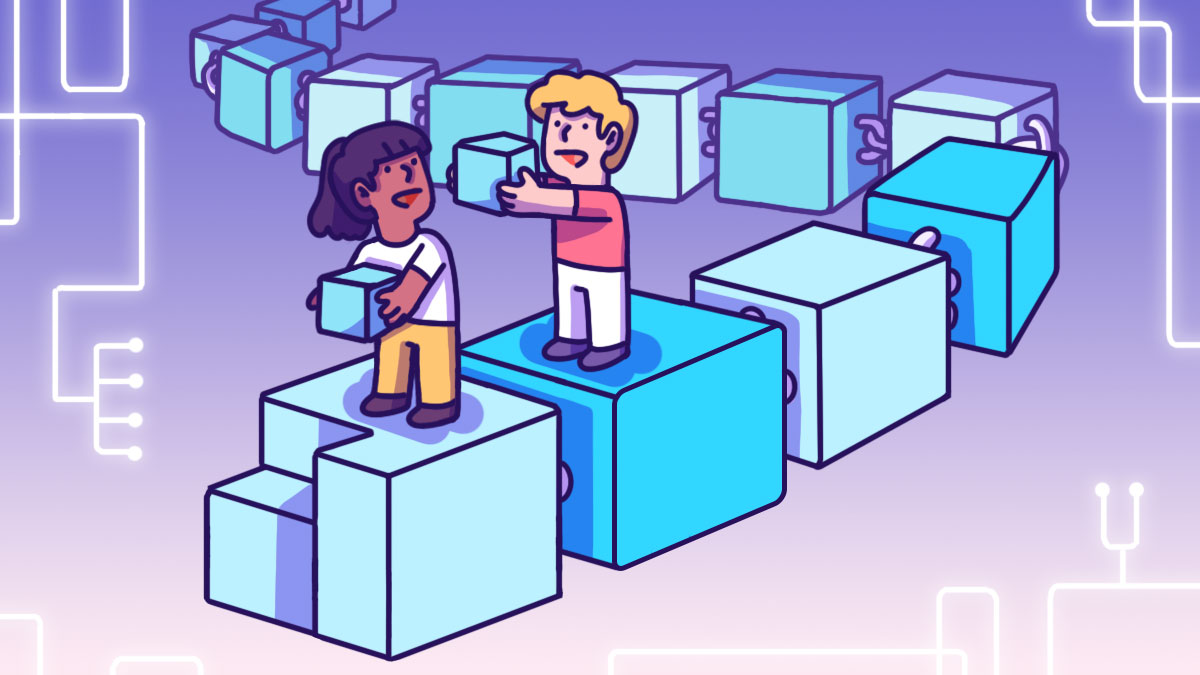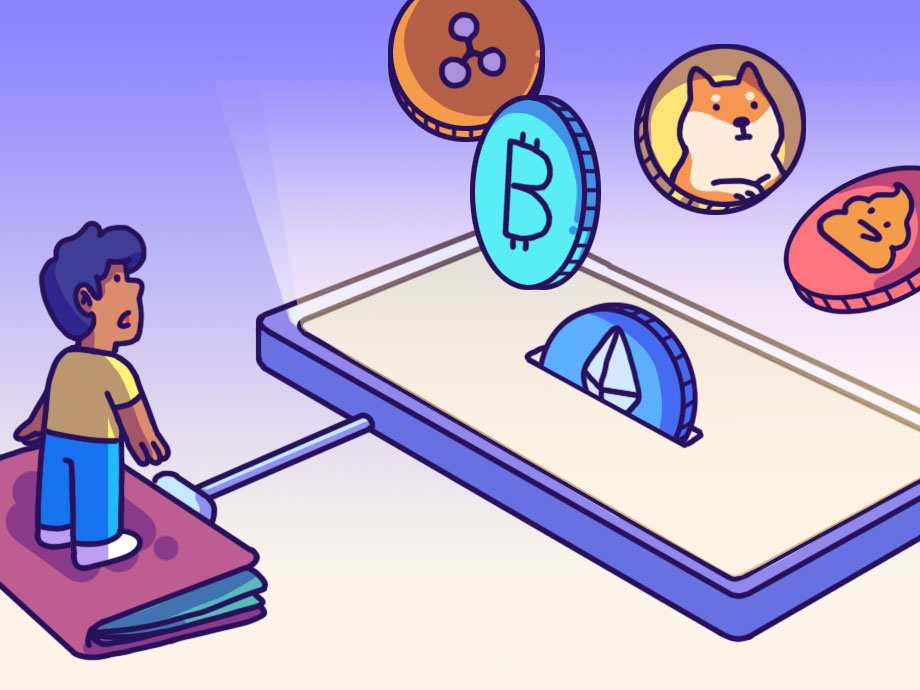Web3 | Article
The Building Block of Web3: Understanding Blockchain
by The Simple Sum Team | 1 Sep 2022 | 7 mins read

When talking about Web 3, you cannot escape understanding blockchain. This is because blockchains are the core technology on which cryptocurrency protocols (cryptocurrencies) such as Bitcoin and Ethereum, and other Web 3 applications are built upon.
The blockchain is a publicly accessible digital ledger or database used to store and transfer information without the need for a central authority.
One key difference between a typical database and a blockchain database is how the data is structured.
In a typical database, data is structured in tables. In a blockchain however, data is structured in chunks (blocks) that are strung together. When a block is filled with data, it becomes part of the chain and is also given a timestamp.
This means any data that is part of the chain is inherently irreversible – it cannot be altered, deleted, or destroyed.
Another key difference between a typical database and a blockchain database is that the blockchain allows data held in that database to be spread out across several network nodes at multiple locations. This allows redundancy and maintains the fidelity of any data stored in the blockchain database.
This system of storing data means that if someone were to tamper with the data in one node, all other nodes can cross-reference each other and easily pinpoint the node with the incorrect data. It also helps to establish an irreversible, exact and transparent order of events.
At present, blockchain technology is being effectively utilised in finance, business and in the government.
The Blockchain in Finance
International Payments
The nature of the blockchain makes it perfect for international payments and money transfers as it provides a way to securely and efficiently create a tamper-proof log of sensitive activity.
An example of this is Banco Santander which launched the world’s first blockchain-based money transfer service known as “Santander One Pay FX” built on the Ripple blockchain. This service uses Ripple’s XCurrent to enable customers to make same-day or next-day international money transfers.
By automating the entire process on the blockchain, Santander has reduced the number of intermediaries typically required in such transactions – making the process more efficient and cheaper, especially in the area of international transfers for their retail clientele.
Capital Markets
A McKinsey report has identified several benefits that blockchain solutions offer capital markets. Such benefits include:
- faster clearing and settlement;
- a consolidated audit trail; and
- operational improvements
Axoni – a startup founded in 2013 – builds blockchain-based solutions specifically for capital market improvement. Most recently, Axoni announced the launch of a distributed ledger network to manage equity swap transactions – enabling both sides of an equity swap to be synchronised throughout their life cycle, and the communication of changes in real time.
Regulatory Compliance and Audit
The secure nature of the blockchain makes it useful for accounting and auditing because it significantly decreases the possibility of human error and ensures the integrity of records. Besides this, account records cannot be altered – not even by the record owners – once these records have been locked in using the blockchain.
Money Laundering Protection
The encryption integral to blockchain makes it helpful in combating money laundering. The underlying technology empowers record keeping which supports the “Know Your Customer” process – the process through which businesses identify and verify the identities of their clients.
Insurance
Possibly the most useful application of the blockchain is in the area of smart contracts. In the insurance arena, this allows both customers and insurers to manage claims transparently and securely as all contracts and claims can be recorded on the blockchain and validated by the network. Hence, invalid claims would be eliminated as the blockchain would reject multiple claims on the same incident.
An example of this is OpenIDL – a network built on the IBM Blockchain Platform with the American Association of Insurance Services. OpenIDL automates insurance regulatory reporting and streamlines compliance requirements.
Related
The Blockchain in Business
Supply Chain Management
The blockchain’s immutable ledger makes it well suited for tasks such as the real-time tracking of goods as they move – and change hands – throughout the supply chain. In such cases, using a blockchain opens several options for companies transporting the goods. This includes allocating goods newly arrived at a port to different shipping containers. Hence, the blockchain provides a new and dynamic means of organising tracking data and putting it to good use.
Healthcare
As specialised and connected medical devices become more common and increasingly linked to a person’s health record, the blockchain can connect those devices to a specific person’s health record. Devices will be able to store the data generated on a healthcare blockchain and append it to personal medical records. This overcomes the key issue facing connected medical devices – the siloed data that these devices generate. Hence, the blockchain could hold the key to bridging these silos.
Real Estate
Singaporeans notwithstanding, the average person will move homes nearly 12 times during their life. With such frequent movement, the blockchain could certainly be of use in the real estate market. It would expedite home sales by quickly verifying finances, reduce fraud thanks to its encryption, and offer transparency throughout the entire selling and purchasing process.
Media
Media companies have already started to adopt blockchain technology to eliminate fraud, reduce costs, and even protect Intellectual Property (IP) rights of content such as music. According to MarketWatch, the global market for blockchain in media and entertainment is estimated to reach $1.54 billion by 2024.
One platform that has taken the spotlight in leveraging the blockchain for media is Eluvio Inc. Formally launched in 2019, Eluvio Content Fabric uses blockchain technology to enable content producers to manage and distribute premium videos to consumers and business partners without content delivery networks.
Energy
Blockchain technology could be used to execute energy supply transactions, and also to further provide the basis for metering, billing, and clearing processes. Other potential applications include documenting ownership, asset management, emission allowances, and renewable energy certificates.
The blockchain in government
Records management
Managing individuals’ records and data such as birth and death rates, marital status, or property transfers can be difficult. Moreover – to this day – some of these records only exist on paper. This means that citizens will need to be physically present in their local government offices to make changes. This can be time-consuming, unnecessary, and frustrating. Blockchain technology could simplify this recordkeeping and make data more secure.
Voting
Blockchain technology can make the voting process more easily accessible while improving security. Hackers would be no match for blockchain technology because even if someone were to access a voting terminal, the person would not be able to affect other nodes. Each vote would be attributed to one identity, and with the ability to create a fake ID being impossible, government officials could tally votes more efficiently and effectively.
Taxes
Blockchain technology could make the cumbersome process of filing taxes – which is prone to human error – much more efficient with enough information stored on the blockchain.
Non-profit agencies
Blockchain could solve the anti-trust problems charities are increasingly facing through greater transparency. The technology has the ability to show donors that Non-Profit Organisations (NPOs) are in fact using their money as intended. Furthermore, blockchain technology could help those NPOs distribute those funds more efficiently, manage their resources better, and enhance their tracking capabilities.
Compliance/Regulatory oversight
The majority of regulatory oversight stems from recordkeeping. However, the consequences of not maintaining records are inarguably much worse. Thus, compliance is non-negotiable for companies. The blockchain can make record updates available to regulators and businesses in real time which – in turn – would reduce time lags and allow red flags and inconsistencies to be spotted sooner.
Related
Other applications
Cybersecurity
The biggest advantage of blockchain in cybersecurity is that it removes the risk of a single point of failure. Blockchain technology also provides end-to-end encryption and privacy.
Big data & data storage
The immutable nature of the blockchain – and the fact that every computer on the network is continually verifying the information stored on it – makes the blockchain an excellent tool for storing big data. This principle also applies to data storage as well.
Internet-of-Things (IoT)
The blockchain is poised to transform practices in a number of IoT sectors. These include…
- Supply chain monitoring/tracking: Tracking the location of goods as they are shipped and ensuring that they stay within specified conditions.
- Asset tracking: Monitoring assets and machinery to record activity and output as an alternative to cloud solutions.



















